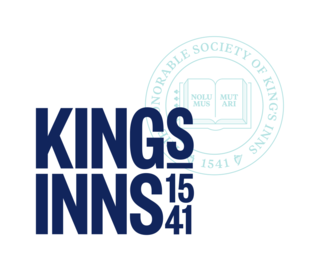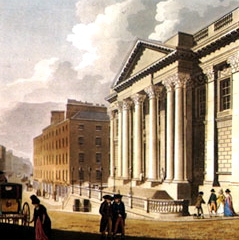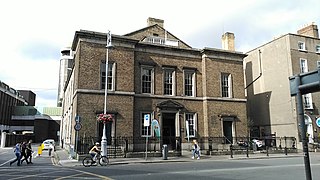
Sir William Chambers was a Swedish-Scottish architect, based in London. Among his best-known works are Somerset House, and the pagoda at Kew. Chambers was a founder member of the Royal Academy.

James Hoban was an Irish-American architect, best known for designing the White House.
The architecture of Ireland is one of the most visible features in the Irish countryside – with remains from all eras since the Stone Age abounding. Ireland is famous for its ruined and intact Norman and Anglo-Irish castles, small whitewashed thatched cottages and Georgian urban buildings. What are unaccountably somewhat less famous are the still complete Palladian and Rococo country houses which can be favourably compared to anything similar in northern Europe, and the country's many Gothic and neo-Gothic cathedrals and buildings.

The Honorable Society of King's Inns is the "Inn of Court" for the Bar of Ireland. Established in 1541, King's Inns is Ireland's oldest school of law and one of Ireland's significant historical environments.

St Mary's Church, Dublin is a former Church of Ireland building on the corner of Mary Street and Jervis Street, Dublin, adjacent to Wolfe Tone Square. From the 17th century, the church was a place of worship for parishioners on Dublin's northside, before it was closed in 1986. The church has since been deconsecrated and the building is now a pub and restaurant. The parish also had a chapel of ease - St Mary's - off Dorset Street, more commonly known as "The Black Church".

Sir Thomas Drew was an Anglo-Irish architect.

Molesworth Street is a street in Dublin, Ireland named after Richard Molesworth, 3rd Viscount Molesworth and links the more notable Dawson Street with Kildare Street and lies just over 200 m to the north of St. Stephens Green in Dublin's central business district.

Thomas Cooley (1740–1784) was an English-born Irish architect who came to Dublin from London after winning a competition for the design of Dublin's Royal Exchange in 1768.

John Tarring FRIBA (1806–1875) was an English Victorian ecclesiastical architect active in the mid-nineteenth century. Based in London, he designed many Gothic Revival churches for Nonconformist clients.

Theodore Jacobsen was an English merchant in London, known also as an architect.

The Bethesda Chapel, Dublin, was an Episcopal Church of Ireland, church on Granby Row and Dorset Street, Dublin.

Trinity Church, Dublin, also called the Protestant Episcopal Church, was a Church of Ireland church on Gardiner Street in Dublin, Ireland, the building of which began in 1838. It closed around 1909 and was reopened in the 2000s by an independent Christian group.
Desmond FitzGerald was an Irish architect. His most notable work is the original Dublin Airport terminal building.
Richard Orpen was an Irish architect, painter, illustrator and designer.

Earlsfort Terrace is a street in Dublin, Ireland which was laid out in the 1830s.

Seán McDermott Street is a street in northeast Dublin, Ireland. It is divided into Seán McDermott Street Lower and Seán McDermott Street Upper.

The Royal Irish Institution (RII) was a Dublin-based art institution established in 1813 to encourage the displaying of fine arts in Ireland.

The Printing House is a classical Palladian style temple building that was constructed within the campus of Trinity College Dublin around 1734 under the tenure of provost Richard Baldwin.















